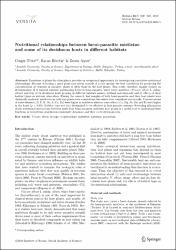Nutritional relationships between hemi-parasitic mistletoe and some of its deciduous hosts in different habitats
Özet
Parasitism of plants by other plants provides an exceptional opportunity for investigating correlative nutritional relationships. Because of lacking a usual plant-root sytem capable of active uptake, the best correlation for predicting the concentrations of elements in parasitic plants is often those in the host plants. This study, therefore, mainly focuses on determination of i) mineral nutrient partitioning between hemi-parasitic white berry mistletoe (Viscum album L. subsp. album) and four of its deciduous hosts growing in different habitats namely wetland and semi-arid and ii) effects of these habitat types on nutrient absorption. During the research, leaf samples of both hemi-parasites and their host plants were chemically analysed, mistletoes on each host plants were counted and the results were considered statistically. Concentrations of some elements (N, P, K, Na, S, Cu, Zn) were higher in mistletoe whereas some others (Ca, Mg, Fe, Mn and B) were higher in the hosts (p < 0.05). Habitat type was also determined to be effective in host-parasite systems. Revealing information about nutritional interactions between multi-host hemi-parasites and their host plants is a useful tool to understand their functions in ecosystems, population-community dynamics and their co-evolution process.
Kaynak
BiologiaCilt
65Sayı
5Koleksiyonlar
- Makale Koleksiyonu [512]
- Scopus İndeksli Yayınlar Koleksiyonu [8325]
- WoS İndeksli Yayınlar Koleksiyonu [7605]


















